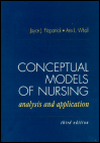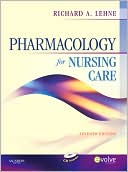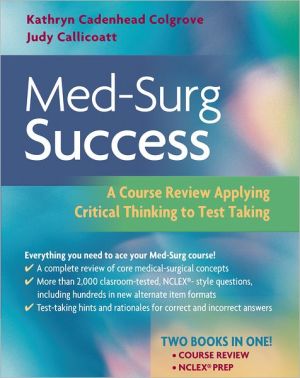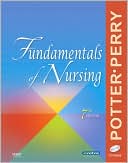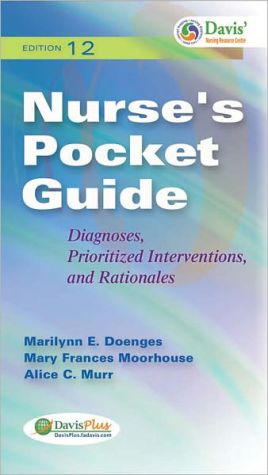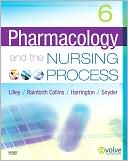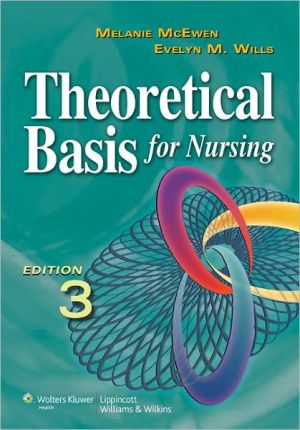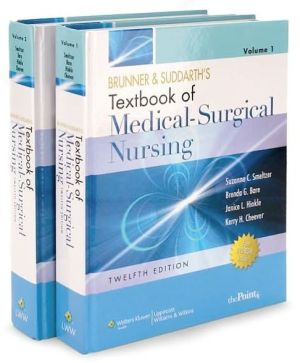Conceptual Models of Nursing: Analysis and Application
This book teaches how to interrelate nursing diagnoses with a variety of conceptual models. The new edition remains focused on major nursing theories, while also adding new chapters on the "Relationship Between Nursing Conceptual Models and Nursing Diagnosis" and the use of "Nursing Diagnosis as a Conceptual Framework." Nursing students.\ \ \ The book contains black-and-white illustrations.\
Search in google:
This book teaches how to interrelate nursing diagnoses with a variety of conceptual models. The new edition remains focused on major nursing theories, while also adding new chapters on the "Relationship Between Nursing Conceptual Models and Nursing Diagnosis" and the use of "Nursing Diagnosis as a Conceptual Framework." Nursing students. Elizabeth R. Lenz This is the third edition of a well respected compendium of information about the works of major nurse theorists. Each of 14 models is described and subjected to an internal analysis of its assumptions, consistency and adequacy and an external analysis of its relation to research, education, and practice. The purpose of the book is to synthesize and extend nurses' familiarity with and ability to critically evaluate models that embody the essence of nursing. This newest edition explores how nursing models might guide newer elements within nursing, such as nursing diagnosis. These objectives are important, and the authors have accomplished them. The book is written primarily for graduate (master's and doctoral) students, but would also be appropriate as a reference for undergraduate students studying nursing theory. The authors are both recognized authorities in the area of nursing theory. There are very few illustrations, but few are needed. References are up-to-date. The book has a pleasant, uncluttered appearance which is appropriate to the subject matter. A desirable feature of the book is that the format for describing the basic components of each theory and for analyzing and evaluating it is consistently applied. Reference lists are excellent. This is the updated version of a classic text in nursing theory. The authors incorporate contemporary views of nursing theory in their general discussion of current debates and issues, and as they describe and evaluate the individual theories. The most unique and valuable aspects of the book are 1) the comprehensive review of research on each model and its application in nursing education and practice, and 2) the relation of eachtheory to nursing diagnosis. This is an essential reference for everyone studying nursing theory.
1Nursing knowledge development : relationship to science and professional practice12The structure of nursing knowledge : analysis and evaluation of practice, middle range, and grand theory53Florence Nightingale : pioneer in nursing knowledge development214Peplau's theory of interpersonal relations465Henderson's conceptualization of nursing686Johnson's behavioral system model837Orem's model of self-care1048Roy's adaptation model1469Leininger's transcultural nursing17710Neuman's systems model19411King's conceptual system and theory of goal attainment22512Martha Rogers' model : science of unitary beings24713Newman's theory of health27314Watson's model of caring29715Fitzpatrick's life perspective rhythm model325
\ From The CriticsReviewer: Elizabeth R. Lenz, PhD, RN, FAAN(Columbia University School of Nursing)\ Description: This is the third edition of a well respected compendium of information about the works of major nurse theorists. Each of 14 models is described and subjected to an internal analysis of its assumptions, consistency and adequacy and an external analysis of its relation to research, education, and practice.\ Purpose: The purpose of the book is to synthesize and extend nurses' familiarity with and ability to critically evaluate models that embody the essence of nursing. This newest edition "explores how nursing models might guide newer elements within nursing, such as nursing diagnosis." These objectives are important, and the authors have accomplished them.\ Audience: The book is written primarily for graduate (master's and doctoral) students, but would also be appropriate as a reference for undergraduate students studying nursing theory. The authors are both recognized authorities in the area of nursing theory.\ Features: There are very few illustrations, but few are needed. References are up-to-date. The book has a pleasant, uncluttered appearance which is appropriate to the subject matter. A desirable feature of the book is that the format for describing the basic components of each theory and for analyzing and evaluating it is consistently applied. Reference lists are excellent.\ Assessment: This is the updated version of a classic text in nursing theory. The authors incorporate contemporary views of nursing theory in their general discussion of current debates and issues, and as they describe and evaluate the individual theories. The most unique and valuable aspects of the book are 1) the comprehensive review of research on each model and its application in nursing education and practice, and 2) the relation of each theory to nursing diagnosis. This is an essential reference for everyone studying nursing theory.\ \ \ \ \ Elizabeth R. LenzThis is the third edition of a well respected compendium of information about the works of major nurse theorists. Each of 14 models is described and subjected to an internal analysis of its assumptions, consistency and adequacy and an external analysis of its relation to research, education, and practice. The purpose of the book is to synthesize and extend nurses' familiarity with and ability to critically evaluate models that embody the essence of nursing. This newest edition explores how nursing models might guide newer elements within nursing, such as nursing diagnosis. These objectives are important, and the authors have accomplished them. The book is written primarily for graduate (master's and doctoral) students, but would also be appropriate as a reference for undergraduate students studying nursing theory. The authors are both recognized authorities in the area of nursing theory. There are very few illustrations, but few are needed. References are up-to-date. The book has a pleasant, uncluttered appearance which is appropriate to the subject matter. A desirable feature of the book is that the format for describing the basic components of each theory and for analyzing and evaluating it is consistently applied. Reference lists are excellent. This is the updated version of a classic text in nursing theory. The authors incorporate contemporary views of nursing theory in their general discussion of current debates and issues, and as they describe and evaluate the individual theories. The most unique and valuable aspects of the book are 1) the comprehensive review of research on each model and its application in nursing education and practice, and 2) the relation of eachtheory to nursing diagnosis. This is an essential reference for everyone studying nursing theory.\ \ \ 3 Stars from Doody\ \
